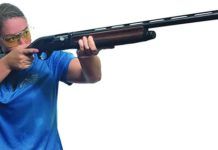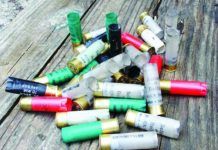While pump-action shotguns have long been the traditional standard for tactical firearms, for self defense and in law enforcement or combat situations, there are several semiautomatics on the market providing another option to the shooting public. Touching off a round with every pull of the trigger in a semiautomatic, rather than having to shuck a shell into the chamber each time with a pump action, just fits the tastes of a lot of shooters on the range and when there is a need for speed in self-defense situations. In most cases, semiautomatics are slightly faster and easier to hold on target than their pump-action cousins. At the request of a reader interested in semiautomatic tacticals, we were able to obtain a trio of these special firearms to test and review. The models included a Benelli Model M4, listing for $1,999; a Beretta Model 1301, listing for $1,075; and a Mossberg Model 930 SPX with a suggested retail of $836. Other than the pistol grip featured on the Benelli, the three shotguns were remarkably similar in appearance, with identical Ghost Ring rear sights. The difference in handling ability and speed proved to be the major factor separating the best from the rest.
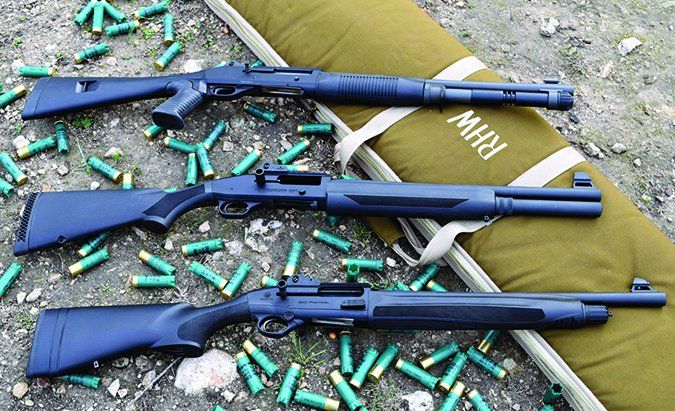
In the days of old, being quicker on the draw often meant the difference between winning and losing a gun battle — with certain caveats. Accuracy and reliable functioning of the firearm were also important in situations where a shooter’s life might depend upon a second, third, fourth, or fifth shot being fired quickly and effectively.
In today’s world, self-defense scenarios in which multiple shots are required to eliminate a threat are, thankfully, rare for most law-abiding citizens. However, there can be cases where personal needs or personal desires can lead a shooter to look at the possibility of putting a semiautomatic shotgun into play.
Such is the case with a Gun Tests reader who contacted us with a request for a review of three semiautomatic tactical shotguns readily available to today’s shooting public. He specifically requested evaluations of a Benelli Model M4, listing for $1,999; a Beretta Model 1301, listing for $1,075; and a Mossberg Model 930 SPX with a suggested retail of $836. While the price range of the three semiautomatics is quite a stretch, the appearance, handling ability, and speed of the trio are very similar.
Just like in the world of clay target shooting, a key factor with semiautomatics is their ability to reliably function. Some shooters have been heard to refer to semiautomatics as “jam-o-matics” because of failures to cycle loads. On the clay target range, a jam at the wrong time can mean the loss of a target; but in a self-defense situation, a jam can leave a shooter holding a club in a gunfight.
Being certain a firearm will function every time is a very important factor in a shooter’s decision to select the right firearm for the right use at the right time. To test the functioning ability, speed of fire, and speed of loading — in addition to checking the accuracy of our three semiautomatics — we selected a trio of loads that could feasibly be put into play as part of potential self-defense or possible close-combat situations. The ammunition included Remington ShurShot Heavy Dove 2.75-inch, 3.25-dram-equivalent loads packing 11⁄8 ounce of No. 6 shot with an average muzzle velocity of 1255 fps; Remington Managed-Recoil No. 00 Buckshot 2.75-inch loads moving eight pellets at an average muzzle velocity of 1200 fps; and Winchester PDX1 Defender 2.75-inch loads pushing a 1-ounce segmented rifled slug at an average muzzle velocity of 1600 fps.
We used Birchwood Casey Eze-Score BC-27 Green Targets for all of our testing, with slug tests at targets set 30 yards downrange (about the maximum for a self-defense situation); and set at 20 yards downrange for the buckshot and No. 6 shot loads. Here are our findings:
Beretta Model 1301 Tactical J131T18 12 Gauge, $1075
GUN TESTS GRADE: A

Just a little lighter and quicker to bring on target, the Beretta performed without a hiccup while producing good patternsand loading fast.
| ACTION TYPE | Semiautomatic |
| CHAMBER SIZE | 2.75 to 3 in. |
| OVERALL LENGTH | 38.25 in. |
| CAPACITY | 5 |
| WEIGHT UNLOADED | 6.25 lbs. |
| WEIGHT LOADED | 6.9 lbs. |
| BARREL LENGTH | 18.5 in. |
| BARREL | Matte black |
| RECEIVER | Matte black |
| CHOKE | Fixed cylinder |
| BUTTSTOCK | Black synthetic, checkered grip |
| BUTTSTOCK LENGTH OF PULL | Adjustable 13.25 to 14.5 in. |
| BUTTSTOCK DROP AT COMB | 1.5 in. |
| BUTTSTOCK DROP AT HEEL | 2.25 in. |
| FOREARM | Black synthetic, checkered |
| FOREARM LENGTH | 13 in. |
| FRONT SIGHT | Interchangeable raised white dot |
| REAR SIGHT | Ghost ring (adjustable) |
| TRIGGER PULL WEIGHT | 5 lbs. |
| WARRANTY | 1 year limited |
| TELEPHONE | (800) 237-3882 |
| WEBSITE | Beretta.com |
| MADE IN | Italy |
This is a very light and quick semiautomatic that is a recent entry into the tactical market. Stand-out features at first glance include the oversized charging handle, a large textured bolt release, and an oversized reversible safety button. We were pleased with both the aesthetics and functionality of these features, along with the deep checkering on both the forearm and stock that earned the Beretta plus marks for easy and secure use.
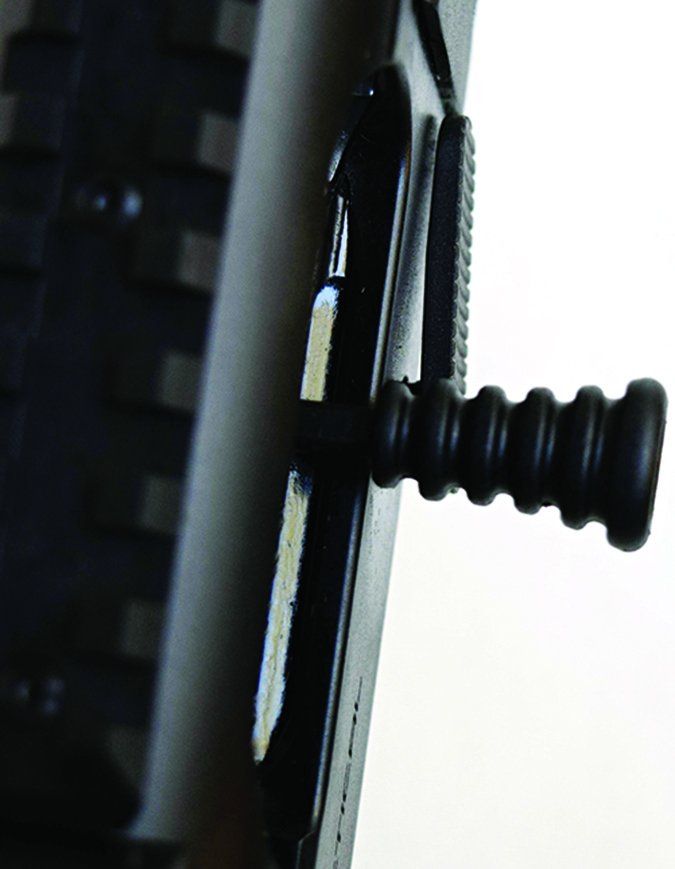
The barrel of the tactical shotgun sat deeper in the forearm than the other models, giving the firearm a sleek look in addition to adding to the quickness factor of getting on targets. With an overall length of 38.25 inches and tipping the scales at just 6.25 pounds (the lightest of the test gun trio), we were pleased with the overall feel and handling ability of the shotgun. It should be noted that we did attach stock spacers included in the box to give the Beretta a length of pull of 14.5 inches, rather than the original 13.25 inches. The longer LOP was more comfortable for our test team, and we also felt that this additional length helped control felt recoil from the various test rounds.
According to the company’s advertising, the Beretta features an integrated Blink gas operating system with a cross tube gas piston; a rotating bolt head lock-up; and a new feeding system that supposedly allows the Model 1301 to cycle 36 percent faster than any other semiautomatic shotgun on the market. We found it cycled faster than either of the other two shotguns in our match-up, but only 0.16 second faster than the Benelli and 0.3 second faster than the Mossberg.
The drop at the comb was 1.5 inches and the drop at the heel was 2.25 inches, providing us with quick and easy target acquisition. We had no problems with putting the semiautomatic into play during speed drills and rapid fire tests. Like the other two test shotguns, the Model 1301 Tactical features a Ghost Ring rear sight system that is also interchangeable, which is very easy to use and quick to put on target even in low-light conditions.
Breaking at a crisp 5 pounds, the trigger pull of the Beretta also earned the shotgun good marks. A nice, crisp, smooth and light trigger pull is a bonus factor appreciated by shotgun shooters almost as much as rifle and pistol aficionados.
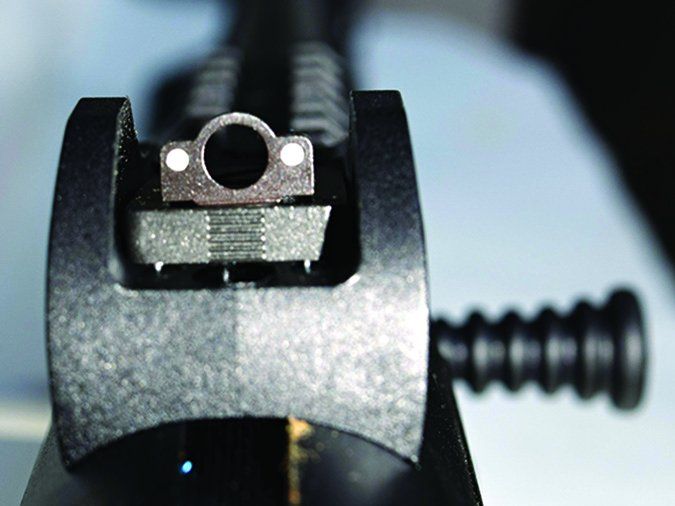
The Beretta fared very well on the range, producing an average 7-inch pattern with slugs at 30 yards and an average 6.75-inch pattern with eight pellets of No. 00 buckshot. Hits were all in the center mass area.
In speed drills, the Beretta outshined the other two test shotguns by a narrow margin, we thought. During the five-shot drill, the shells were all touched off in exactly 1.0 second. The first shot was at 0.45, followed by a shot at 0.71, 0.96, 1.20 seconds, and 1.45 seconds. Shots were alternately fired at two separate targets about 2 feet apart in a very effective manner.
To test the speed-loading ability of the shotgun, we started with a chambered round and another round in our left hand (each member of our test team is right handed). At the sound of the beep from the timer, the chambered round was fired, a round was then dropped in the open chamber, the action was closed and another shot was touched off. The drill was completed in an average of 2.79 seconds, well under the times for either the Mossberg (3.66 seconds) or the Benelli (4.03 seconds). Both speed-drill shots were on target, and we were impressed with the quick, accurate performance of the 1301.
As noted earlier, felt recoil with the Beretta was not considered uncomfortable with any of the loads, and there were zero malfunctions during any of the live-fire testing.
Our Team Said: The 1301 was a lighter, quicker and easier-to-handle shotgun than the other two semiautomatics. We believe the Beretta will meet and exceed the needs of the shooting public seeking a self-defense firearm. Falling in the middle of the price range of the trio didn’t hurt in our evaluation of the semiautomatic.
Mossberg Model 930 SPX Tactical No. 85360 12 Gauge, $836
GUN TEST GRADE: B

We were a little disappointed in the Mossberg’s patterning, but did not consider the slightly larger groups to be a deal breaker. The lighter hit to the pocket book, along with its handling ability and flawless functioning, were key factors in our ranking.
| ACTION TYPE | Semiautomatic |
| CHAMBER SIZE | 2.75 to 3 in. |
| OVERALL LENGTH | 39 in. |
| CAPACITY | 8 |
| WEIGHT UNLOADED | 7.5 lbs. |
| WEIGHT LOADED | 8.25 lbs. |
| BARREL LENGTH | 18.5 in. |
| BARREL | Matte black |
| RECEIVER | Flat black |
| CHOKE | Fixed cylinder |
| BUTTSTOCK | Black synthetic |
| BUTTSTOCK LENGTH OF PULL | 14.25 in. |
| BUTTSTOCK DROP AT COMB | 1.25 in. |
| BUTTSTOCK DROP AT HEEL | 1.5 in. |
| FOREARM | Black synthetic |
| FOREARM LENGTH | 11.25 in. |
| FRONT SIGHT | Elevated red fiber optic |
| REAR SIGHT | Ghost ring (adjustable) |
| TRIGGER PULL WEIGHT | 6 lbs. |
| WARRANTY | 2 year limited |
| TELEPHONE | (800) 363-3555 |
| WEBSITE | Mossberg.com |
| MADE IN | USA |
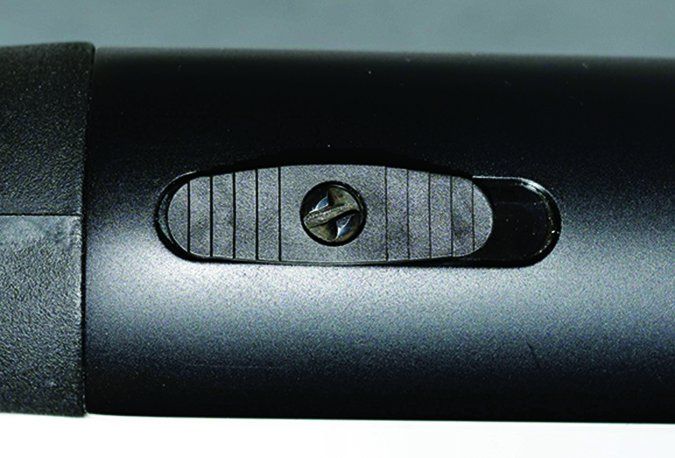
Almost a mirror image of the Beretta, but just a little larger and heavier, the Mossberg also had a good heft and balance right out of the box. Available for just a bit more than $800, we were impressed with the way the Mossberg provided a solid platform and moved well between the hands when acquiring targets.
The Mossberg weighed in at 7.5 pounds and measured 39 inches in length with a length of pull of 14.25 inches. The drop at the comb was 1.25 inches and the drop at the heel was 1.5 inches. Those measurements were very comfortable for our shooting team.
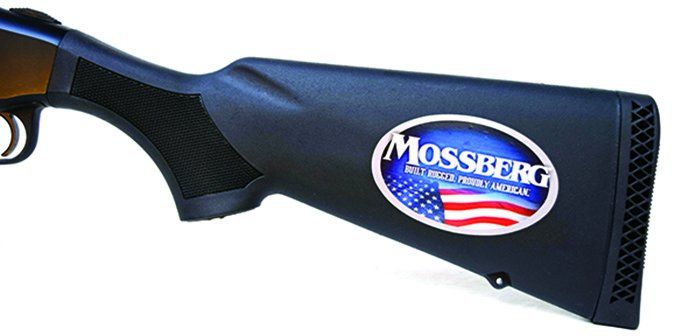
Like the Beretta, the Mossberg also features an oversized bolt knob that allows a shooter to easily open the action. We were also very pleased with the Mossberg’s safety located on top of the receiver. This type of safety is easy to find and operate, even when wearing gloves or in low-light conditions.
Rather than the white-dot front sight of both the Beretta and the Benelli, the Mossberg features a red fiber-optic bar that is quite easy to see, even in low-light conditions, through the Ghost Ring rear sight.
While it was not uncomfortable to handle and fire, the checkering on the Mossberg’s forearm and stock was a little less sharp than that of the Beretta and did not provide quite as good a shooting platform as we would have liked.
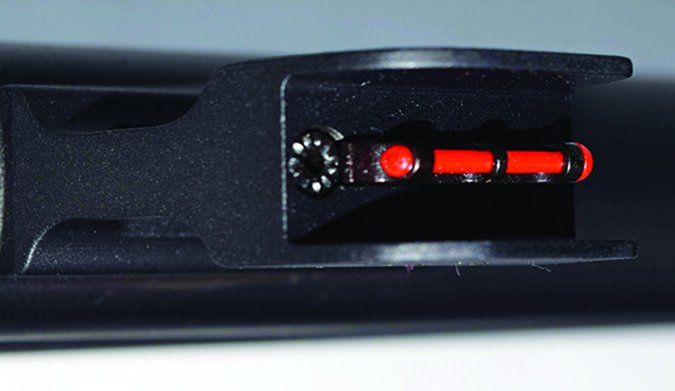
The trigger pull was just a little more than 6 pounds — not a deal breaker, but a little harder than what we would consider in the desirable range. There was no creep in the crisp pull.
During the live-fire testing, the Mossberg did not perform as well as either the Beretta or the Benelli. With the slugs, the Mossberg produced an 8.5-inch group of five shots at 30 yards, with a tendency to pull a little low left rather than stay dead center mass like the other two semiautomatics. The 20-yard test of No. 00 buckshot also seemed to have a tendency to hit a little low and left, with an average group of 8 pellets covering an 8-inch spread.
In the speed tests, we averaged a 1.3 second string of five shots; the first at 0.48 of a second; the second at 0.85 of a second; the third at 1.16 seconds; the fourth at 1.46 seconds, and the fifth at 1.78 seconds. That was 0.30 of a second slower than the Beretta and 0.14 of a second slower than the Benelli — a razor thin difference to be sure, but still slightly slower.
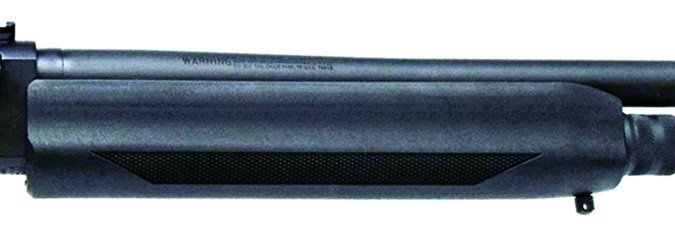
Putting the timer on a one-shot reloading drill, the Mossberg could be fired, reloaded, and fired again in 3.66 seconds, which was slower than the Beretta but faster than the Benelli. Like the Beretta, we felt the Mossberg was easy to handle and keep on target even during the rapid-fire testing.
Our Team Said: The low price is a big selling point for this semiautomatic that is just a bit bigger, heavier, and slightly harder to handle than the higher-priced Beretta. Other than the slightly poorer patterning performance, the Mossberg seems to be quite capable of serving as a solid shooting tool for self-defense situations.
Benelli Model M4 Tactical No. 85360 12 Gauge, $1999
GUN TEST GRADE: B-

Acknowledging its reputation as a fine military shooting tool, we could not get past its higher price and failure to cycle low-velocity loads during our field tests. In addition, a 12-pound trigger pull borders on unacceptable in our ranking of a high-quality self-defense firearm.
| ACTION TYPE | Semiautomatic |
| CHAMBER SIZE | 2.75 to 3 in. |
| OVERALL LENGTH | 39.75 in. |
| CAPACITY | 5 |
| WEIGHT UNLOADED | 8 lbs. |
| WEIGHT LOADED | 8.75 lbs. |
| BARREL LENGTH | 18.5 in. |
| BARREL | Matte black |
| RECEIVER | Matte black |
| CHOKE | Screw-in internal (mod included) |
| BUTTSTOCK | Black synthetic pistol grip |
| BUTTSTOCK LENGTH OF PULL | 14.75 in. |
| BUTTSTOCK DROP AT COMB | 1.5 in. |
| BUTTSTOCK DROP AT HEEL | 2.5 in. |
| FOREARM | Black synthetic |
| FOREARM LENGTH | 7.75 in. |
| FRONT SIGHT | Elevated white dot |
| REAR SIGHT | Ghost ring (adjustable) |
| TRIGGER PULL WEIGHT | 12 lbs. |
| WARRANTY | 10 year limited |
| TELEPHONE | (800) 264-4962 |
| WEBSITE | BenelliUSA.com |
| MADE IN | Italy |
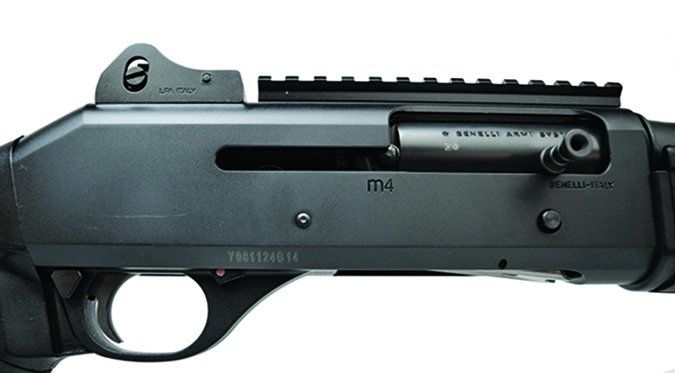
The heavyweight of the group, also sporting the highest price tag, the Benelli has the heft and feel of a rugged shooting tool. As noted earlier, the shotgun we were provided for our test and review featured a full pistol-grip stock designed to help lock the firearm into shooting position. This type of grip works fine when the shotgun is snuggled into a shooter’s shoulder, but can hinder the process of loading or cycling the action.
Weighing in at 8 pounds with an overall length of 39.75 inches, the Benelli was the big boy on the block in this semiautomatic match-up. We found the shotgun was not as well balanced and comfortable to handle as either of the other two semiautomatics in the test. Admittedly, there are some shooters who simply do not favor a full pistol grip on a stock, so personal preference may have influenced our evaluation.
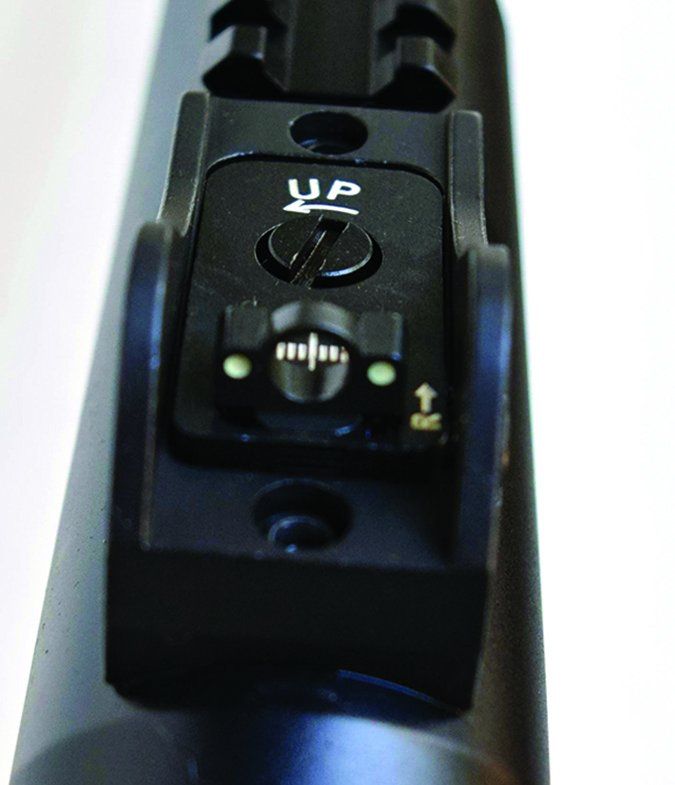
In addition, we found the 7.75-inch grooved forearm (the shortest forearm among the trio) a little harder to handle than the other two semiautomatics, making it just slightly slower to bring on target.
We should note that the M4 was designed in 1998 for use by the U.S. Marine Corps and is the current combat service shotgun of the U.S. Joint Services — a testament to a firearm getting the job done efficiently and effectively. Still, one major downside we found in the Benelli was the very sluggish trigger pull with a 12-pound touch off. While not as important as it is with rifle and pistol shooters, trigger pull can still be a factor when shooting a scattergun to effectively engage a target. We would recommend a gunsmith adjustment on this firearm that would reduce the pull weight to somewhere in the 5- to 7-pound range.
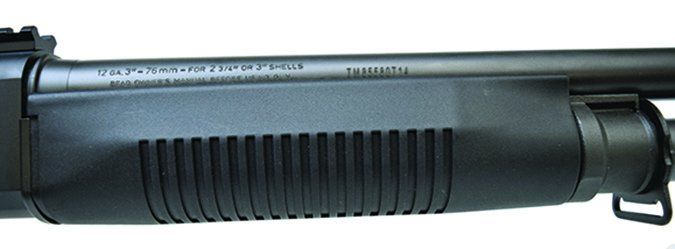
Unlike the other two shotguns with fixed chokes, the Benelli featured a barrel threaded for internal choke tubes (a modified tube was supplied with the test firearm), providing shooters with a choke option for handling various shooting situations. The modified choke was most likely a factor in the patterning performance of the Benelli. A 4-inch group was produced with the slugs and an average group with the No. 00 buckshot measured just 5.5 inches across. Both groups were the best of all the test shotguns and were quite impressive.
We did encounter a problem with the managed-recoil buckshot loads that had an average muzzle velocity of 1,200 per second. The Benelli failed to eject or cycle any of the buckshot rounds. This could cause problems for shooters attempting to practice with low-velocity loads in order to reduce shoulder shock.
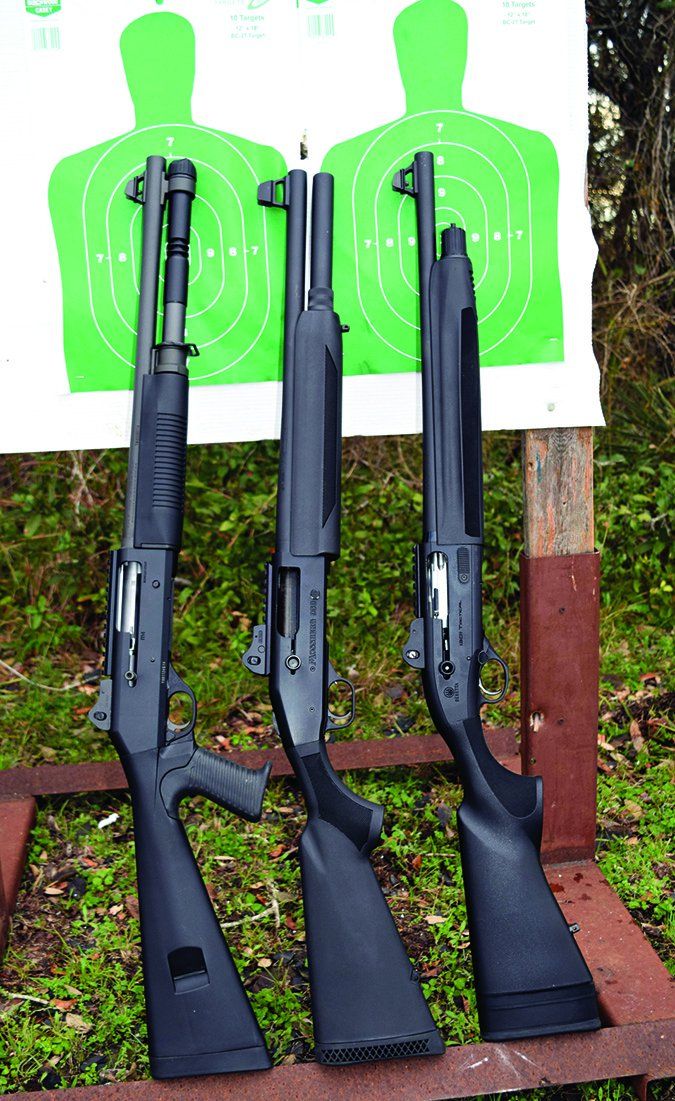
In the speed-loading test, the Benelli was a distant third. An average of 4.03 seconds was required to fire, reload, and fire again. During the five-shot drill, the Benelli could be cycled in an average of 1.16 seconds, with the first shot at 0.46 of a second; the second at 0.77 of a second; the third at 1.06 seconds; the fourth at 1.33 seconds, and the final shot at 1.62 seconds.
Our Team Said: We found the Benelli was just not quite as smooth handling as either of the other two shotguns, and we were a little uncomfortable with its bulk. While it has a solid history of rugged military use, we found the M4 does not transcend into home-defense mode as well as the other two shotguns in the test. Retailing for just under $2,000, we expected more from this Benelli semiautomatic that has a history of providing our military with a fine shooting tool. The heavy trigger pull of 12 pounds, its slightly clunky handling ability, and failure to cycle low-velocity ammunition were all factors lowering the ranking of this self-defense firearm.
Written and photographed by Ralph Winingham, using evaluations from Gun Tests team testers.


























